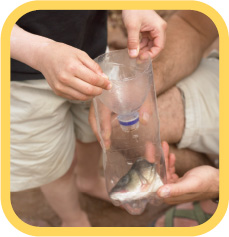
Полная версия
Seashore
Nick’s trick
In an area where netted dog whelks are found, try dragging your bait around on a sandy bottom and watch what happens. These scavenging snails will follow the trail, siphons up, as they pick up the smell of the bait.
YOU WILL NEED
> old plastic drinks bottle
> scissors
> bait
> gaffer tape
> string
> plastic tank

1 Take the bottle and cut off the top about 10cm down (you might need to ask an adult to help you as this can be difficult). You will be left with a funnel and a trap box. Then make lots of small holes in the main part of the bottle.

2 Put some bait into the trap and insert the top of the bottle, neck end down. Fasten in place with strips of gaffer tape.

3 Search out some large, flat stones and attach them to the bottle using string. They look like little packages and will weight down your trap, which is important as a drifting trap spells death for all those caught inside. Plastic bottles are also one of the worst kinds of litter.

4 Position the trap in a rock pool and then leave for a few hours.

5 You will want to take a closer look at what you’ve caught, so carefully place your captives in an observation tank to study them.
Marvellous molluscs
These simple little cone-shaped shells are a familiar sight on a wave-beaten rocky shore. Their shell design and body shape are perfect for resisting the constant battering of the ocean. These molluscs have a large circular foot, which allows them to clamp tight to the rocks on which they live, making them very hard to prise off the rocks without doing any damage.
A combination of their habitual behaviour and the abrasive action of their shells on the rock means that they will often wear away the rock’s surface, leaving small circular pits as evidence of their home base. You can also sometimes see grazing trails similar to those left by their land-based relatives, the garden snails.
You might think that watching limpets is about as much fun as watching your parents tan! But you can turn even the dullest beach into a study zone. What do you know about these little molluscs? Not a lot, OK. So follow the steps opposite and you will learn a little bit more. This technique is used by biologists to study the movement of all kinds of animals.

Nick’s tricks
* You can take limpets by surprise! If you catch one with its shell slightly raised and you are quick, with one deft movement of your hand you can flick them off, giving you a chance to see the animal itself. Remember to put them back exactly where you found them.
* To see a limpet even more clearly, pop one inside a clear-sided observation tank and you will get a rock’s point of view of these often taken-for-granted tough little rock pool characters.
YOU WILL NEED
> quick-drying, non-water-based model paint in any bright colour
> paintbrush
> paper
> pencil

1 Using the model paint and paintbrush, mark a few limpets on a rock with a tiny blob of coloured paint.

2 Draw a map of the rocks and the positions of your colour-coded limpets.

3 Return the next day. Have they moved? Most of them probably won’t have, but some may well have moved a surprising distance. To find out just how much they do shuffle about, return to the same spot at night on a low tide. Try to find your molluscs then – you’ll be surprised . . .
Take it further
* Don’t feel you should limit your marking studies to limpets. You can try similar studies with any hard-shelled creatures, such as winkles and crabs.
* Use different-coloured paints for limpets on different rocks. With time, will they intermingle?
Shell collecting
The seashore is a tough place to live for a soft-bodied creature. There is the continuous pounding of the waves and the constant threat from predators from the sea, land and air. Then, for those creatures that live on the main part of the beach, there is the threat of being left out in the open, exposed to the drying effects of the wind and the sun. Five minutes of summer sun could turn a succulent, soft sea slug into a crisp!
One easy fix for all of these survival problems is to live in your own portable, environmental protection suit, which is exactly what a sea shell is to a snail!
Any strand line, anywhere in the world, will probably have some of these beautiful structures, cast up from the ocean, their original molluscan creators long since gone. Be warned, though, shell collecting is very addictive. Once you have started walking a strand line, you will be surprised just how far you have strolled, eyes down searching for the next piece of natural treasure!
Конец ознакомительного фрагмента.
Текст предоставлен ООО «ЛитРес».
Прочитайте эту книгу целиком, купив полную легальную версию на ЛитРес.
Безопасно оплатить книгу можно банковской картой Visa, MasterCard, Maestro, со счета мобильного телефона, с платежного терминала, в салоне МТС или Связной, через PayPal, WebMoney, Яндекс.Деньги, QIWI Кошелек, бонусными картами или другим удобным Вам способом.







